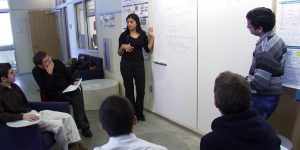 Three groups of students from Associate Professor of Biomedical Engineering and ICM Core faculty Member, Sridevi Sarma‘s spring 2017 classes successfully turned group research projects into papers that have been accepted into the 39th Annual International Conference if the IEEE Engineering in Medicine and Biology Society (EMBC ’17). One duo, Kristin Gunnarsdottir, Biomedical Engineering PhD student, and Vijay Sadashivaiah, Biomedical Engineering Masters student, turned their project from Dr. Sarma’s Introduction to Computational Medicine course into a paper titled, “Using demographic and time series physiological features to classify sepsis in the intensive care unit.”
Three groups of students from Associate Professor of Biomedical Engineering and ICM Core faculty Member, Sridevi Sarma‘s spring 2017 classes successfully turned group research projects into papers that have been accepted into the 39th Annual International Conference if the IEEE Engineering in Medicine and Biology Society (EMBC ’17). One duo, Kristin Gunnarsdottir, Biomedical Engineering PhD student, and Vijay Sadashivaiah, Biomedical Engineering Masters student, turned their project from Dr. Sarma’s Introduction to Computational Medicine course into a paper titled, “Using demographic and time series physiological features to classify sepsis in the intensive care unit.”
Abstract: “Sepsis, a systemic inflammatory response to infection, is a major health care problem that affects millions of patients every year in the intensive care units (ICUs) worldwide. Despite the fact that ICU patients are heavily instrumented with physiological sensors, early sepsis detection remains challenging, perhaps because clinicians identify sepsis by (i) using static scores derived from bed-side measurements individually, and (ii) deriving these scores at a much slower rate than the rate for which patient data is collected. In this study, we construct a generalized linear model (GLM) for the probability that an ICU patient has sepsis as a function of demographics and bedside measurements. Specifically, models were trained on 29 patient recordings from the MIMIC II database and evaluated on a different test set including 8 patient recordings. A classification accuracy of 62.5% was achieved using demographic measures as features. Adding physiological time series features to the model increased the classification accuracy to 75%. Although very preliminary, these results suggest that using generalized linear models incorporating real time physiological signals may be useful for an early detection of sepsis, thereby improving the chances of a successful treatment.”
Matthew Walmer and Sam Sklar, both Masters students in the department of biomedical engineering, co-authored a paper titled, “Neuronal Activity in Human Anterior Cingulate Cortex Modulates with Internal Cognitive State During Multi-Source Interference Task,” which evolved from a project in Dr. Sarma’s Models of the Neuron course.
Abstract: “The dorsal anterior cingulate cortex (dACC) is thought to be essential for normal adaptation of one’s behavior to difficult decisions, errors, and reinforcement. Here we examine single neurons from the human dACC in the context of a statistical model, including a cognitive state that varies with changes in cognitive interference induced by a Stroop-like task. We then include this cognitive state in point process models of single unit activity and subject reaction time. These results suggest that consideration of a latent cognitive state can explain additional variance in neural and behavioral dynamics.”
Juniors in the department of Biomedical Engineering, Callie Deng and Tony Sun along with Biomedical Engineering Graduate student, Manning Zhang, are among the authors of a paper titled, “Effects of the Temporal Pattern of Subthalamic Deep Brain Stimulation on the Neuronal Complexity in the Globus Pallidus,” which developed from a group project for Dr. Sarma’s Models of the Neuron course.
Abstract: “Deep brain stimulation (DBS) is a surgical treatment for Parkinson’s disease (PD) but, despite clinical efficacy, the mechanisms of DBS still require investigation. Recent evidence suggests that the temporal pattern of the electrical pulses may be critical to the therapeutic merit of DBS and carefully-designed, non-regular patterns could ameliorate some of the motor symptoms in PD. It is unclear, though, how different stimulation patterns affect the neural activity in the basal ganglia and whether this is related to the pathophysiology of PD. In this study, a non-human primate was treated with DBS of the subthalamic nucleus while single-unit recordings were collected in the animal’s globus pallidus internus (GPi). Three stimulation patterns were applied (one regular, two non-regular) and the stimulation effects on the GPi spike trains were assessed via point process modeling. On a preliminary set of 23 GPi neurons, we show that regular DBS maximized the neuronal complexity, which is a measure of the amount of information that a single neuron can encode, and significantly increased the dependency of the neurons’ spike trains on the background ensemble activity through an articulated balance of excitation and inhibition. Overall, regular DBS caused the largest modulation in the neurons’ spiking pattern and the largest increment in encoding capabilities. Both results may be relevant to the mechanisms of therapeutic DBS.”
The 39th Annual EMBC will be held in Jeju Island, Korea from July 11 to 15, 2017 and will cover diverse topics of cutting-edge research in biomedical engineering, healthcare technology R&D, translational clinical research, technology transfer and entrepreneurship, and biomedical engineering education.

